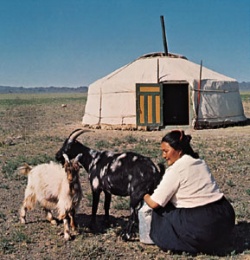Difference between revisions of "Mongolia"
(Created page with "thumb|250px| Mongolia is a huge but thinly-populated country between China and Russia. Vajrayāna Buddhism was introduced into Mongolia from Tibet af...") |
|||
| (One intermediate revision by the same user not shown) | |||
| Line 1: | Line 1: | ||
[[File:8694-004-4E0.jpg|thumb|250px|]] | [[File:8694-004-4E0.jpg|thumb|250px|]] | ||
| − | |||
| − | The Religions of Mongolia, W. Heissig, 1979. | + | |
| + | |||
| + | [[Mongolia]] is a huge but thinly-populated country between [[China]] and [[Russia]]. | ||
| + | |||
| + | [[Vajrayāna Buddhism]] was introduced into [[Mongolia]] from [[Tibet]] after the 15th century and in time the whole population became [[Buddhist]]. | ||
| + | |||
| + | In the early 1920’s, the country’s government became [[communist]] and during the next decade all [[temples]] and [[monasteries]] were closed and all [[monks]] were either murdered, imprisoned or fled into exile. | ||
| + | |||
| + | It was only with the reintroduction of {{Wiki|democracy}} in 1990 that [[Mongolians]] were free again to practise their [[religion]]. | ||
| + | |||
| + | Today, a majority of [[Mongolians]] still call themselves [[Buddhists]], but the [[Saṅgha]] has been slow to recover from decades of persecution and a deep [[knowledge]] of the [[Dhamma]] by the [[people]] is not common. | ||
| + | |||
| + | The [[Religions]] of [[Mongolia]], W. Heissig, 1979. | ||
{{R}} | {{R}} | ||
[http://www.buddhisma2z.com/content.php?id=273 www.buddhisma2z.com] | [http://www.buddhisma2z.com/content.php?id=273 www.buddhisma2z.com] | ||
[[Category:Buddhist Terms]] | [[Category:Buddhist Terms]] | ||
[[Category:Mongolia]] | [[Category:Mongolia]] | ||
Latest revision as of 12:05, 20 March 2016
Mongolia is a huge but thinly-populated country between China and Russia.
Vajrayāna Buddhism was introduced into Mongolia from Tibet after the 15th century and in time the whole population became Buddhist.
In the early 1920’s, the country’s government became communist and during the next decade all temples and monasteries were closed and all monks were either murdered, imprisoned or fled into exile.
It was only with the reintroduction of democracy in 1990 that Mongolians were free again to practise their religion.
Today, a majority of Mongolians still call themselves Buddhists, but the Saṅgha has been slow to recover from decades of persecution and a deep knowledge of the Dhamma by the people is not common.
The Religions of Mongolia, W. Heissig, 1979.
